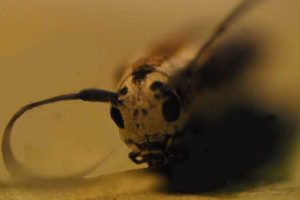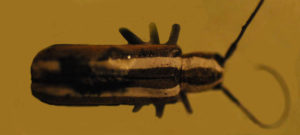Saberda candida
Quite possibly the greatest scourge of the apple tree in an inch long package.
This is a large beetle whose larvae do considerable damage to fruit trees by eating and tunneling in the trunk. The damage often leads to major tree decline or death.
- Physiology : Saperda candida belongs to the cerambycid family, the broad group that encompasses the longhorned beetles. The “horns” referred to are the dramatically long antennae, often measuring as long as the body length. This adult insect is an average of 1 inch long from the base of the abdomen to the tip of the head, and may double when including those antennae. It has a brown or grayish dorsal half accented by two white lines running longitudinal the full length. The ventral portion (beneath) is a silvery white. Fine hairs cover the entire body. Antennae and legs are gray. It is an attractive creature, and quite easily spotted when in the open. When handled it becomes angry and animated with a clearly audible hissing. The mandibles are quite powerful (I had one clamped on to my fingernail and dangling, whose removal took some firm pulling). Larvae : are variable in size according to their age, but at near maturity can be as long as the adult beetle. These are a tan to white segmented creature, with a row of tiny darker dots running its length (respiratory units). The head is a deep brown and stands out from the worm like body. Jaws are sharp and black.
- Life Cycle : Early season activity depends on geographical location. The following dates are for the far northeastern areas of the US, such as Vermont and Maine.
- Adult beetle emerges in the first two weeks of June. Emergence holes are chewed through the bark and are more circular than oval, 3/16 to ¼ inch in diameter. They are often active in the foliage, feeding on leaves, twigs, and fruit. Mating occurs about a week later.
- Soon after mating, the female begins egg laying. Normally hiding during the daylight hours she can live for 40 days or longer. She chews a vertical slit in the bark of the host tree with her mandibles and lays an egg between the bark and xylem. Site of ovipositing is low on the trunk, often near the soil line. The beetle then glues the wound with a gluey substance she secretes. Egg laying can last into August.
- Eggs are 1/8 inch long and one third as wide. They are cream or white but turn brownish with age. Hatching occurs 2 to 3 weeks following laying.
- Larvae begin by feeding on tissue between the bark and sapwood. This damaging activity normally begins by September. They slowly chew deeper and deeper into the trunk in various directions. Younger larvae sometimes head lower, to beneath the soil level, but older individuals crawl higher. All activity of the larval stage is within the trunk. Their excrement is often visible as a rust/tan sawdust-like material, exuded from a hole and onto the bark.
- Larvae continue eating within the tree throughout the next growing season and growing larger. Some may remain for 4 years and do extensive damage.
- The larva begins pupation in its final year within the trunk. This occurs in late fall or early spring, with the adult emerging after one month in the pupal stage. The adult flies or crawls off to repeat the cycle.
Region and Hosts : This is primarily an insect of the Eastern US, but may occur in other areas. It is known in areas of Europe as well. Host trees include apple, pear, hawthorn, quince, amelanchier, mountain ash, cotoneaster.
Damage : Trees begin to suffer with the first bites of the larvae. The cambium is damaged along with the rest of the trees transport system. Trees with progressing damage will appear sickened, with yellowing or stunted foliage and low vigor. Suckering may occur beneath affected areas. Secondary problems include the onset of disease through wounded tissue. Advanced stages and repeated attack will lead to a brittle trunk structure, with younger trees breaking off completely. Older trees can often weather the onslaught reasonable well, but at the expense of longevity and health.
Prevention and Cure : Vigilance is important with this pest. Observation of your trees will result in success in dealing with this nuisance. These tips can help:
- Keep it clean. No grass, weeds or debris should obscure the trunk area of a 1 foot diameter. (Review the recommendations in the tree planting section on the website) The adult beetle is happy to have cover when she is laying eggs, so make the area unfriendly to her. Insects in the open are easy prey for our feathered friends. A clean area will also make it easy to spot damage on the trunk.
- Periodically look for damage or egg slits. The newly deposited egg or young larvae can easily be scraped to oblivion with the average fingernail. The real telltale sign of invasion, though is the fibrous tan exudation known as “frass”. This woody dust often spill out of the tree on its own, but sunken or discolored areas on the trunk can be gently cut open to reveal the mess.
- Go hunting. Probing ever deeper into the hole will eventually yields a speared larva. My weapon of choice is a malleable wire about 4 inches long. Bend the wire 1/16 of an inch from the tip and knick it with shears to create some barbs. This will allow the culprit to be pulled from its hiding place into the light of day. If the larva has made excess twists and turns, it may be necessary to do some serious surgery with a sharp knife to find him. Cutting into live cambium for certain is not a good thing, but will usually result in far less damage than will occur if the borer is left inside.
- Some folks elect to inject a pesticide into the hole. There are organically approved substances such as pyrethrum or spinosad that may have effect, but beetles by their very nature are a tough bunch.
- Preventives. – Coating the trunk with a whitewash may offer some protection. Although a latex paint is commonly used, a more natural approach is to make a slurry of clay and apply that. Some folks (like us) have even added thickening or abrasive agents like sand or spackle. If it is thick enough, it will deter them. There are a few problems with the method, though. First, trees do engage in some respiration through their bark and covering it too thickly can prevent this. Second, it will become more difficult to notice borer activity, such as sunken areas. Make sure you do a thorough search of the tree and destroy all larva before sealing. The good news is that frass will show up nicely when a new larva moves in. White washes have the added bonus of minimizing southwest injury (sunscald).
-Closing off the lower trunk with screening may kind of, maybe, lessen the chance of attack. The idea is to have in place a cylinder of screen about 2 inches from the trunk, buried below the soil level, and wrapped tight at the upper end. The portion that contacts trunk must be protected with a soft material like cloth or foam, and periodically checked for disease or borer damage. Physical barriers like this, and coatings as well, often only change the location of borer entry. Although it is easier to deal with eradicating it from a higher physical position, it will not usually keep the tree from being attacked. They will often lay eggs beneath the material where guards touch bark.
Again, persistence is key here. By checking the base of the tree several times a year and digging out the culprit as soon as he is discovered is the way to go. Many commercial orchards use a soil drench of insecticide which works systemically to kill borer larva, in addition to aerial sprays to combat adults. We do not support these methods due not only to organic regulations, but in terms of the health of the orchard and its inhabitants…like me.



